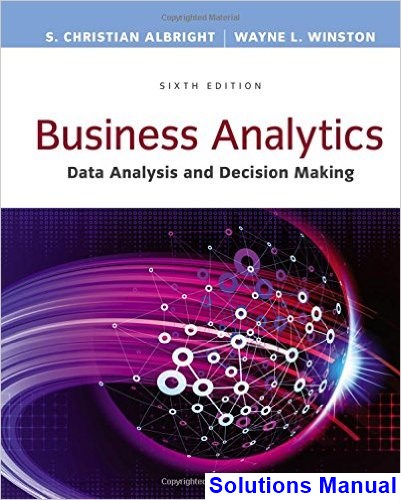This is completed downloadable of Business Analytics Data Analysis and Decision Making 6th Edition Albright Solutions Manual.

Instant download Business Analytics Data Analysis and Decision Making 6th Edition Albright Solutions Manual pdf docx epub after payment.
Product Details:
- ISBN-10 : 1305947541
- ISBN-13 : 978-1305947542
- Author: S. Christian Albright
Become a master of data analysis, modeling, and spreadsheet use with BUSINESS ANALYTICS: DATA ANALYSIS AND DECISION MAKING, 6E! This popular quantitative methods text helps you maximize your success with its proven teach-by-example approach, student-friendly writing style, and complete Excel 2016 integration. (It is also compatible with Excel 2013, 2010, and 2007.) The text devotes three online chapters to advanced statistical analysis. Chapters on data mining and importing data into Excel emphasize tools commonly used under the Business Analytics umbrella — including Microsoft Excel’s “Power BI” suite. Up-to-date problem sets and cases demonstrate how chapter concepts relate to real-world practice.
business analytics data analysis and decision making 6th edition
business analytics data analysis and decision making
business analytics data
Table Of Content:
- Preface
- Chapter 1: Introduction to Business Analytics
- 1-1 Introduction
- 1-2 Overview Of The Book
- 1-2a The Methods
- 1-2b The Software
- 1-3 Modeling And Models
- 1-3a Graphical Models
- 1-3b Algebraic Models
- 1-3c Spreadsheet Models
- 1-3d A Seven-Step Modeling Process
- 1-4 Conclusion
- Part 1: Exploring Data
- Chapter 2: Describing the Distribution of a Single Variable
- 2-1 Introduction
- 2-2 Basic Concepts
- 2-2a Populations and Samples
- 2-2b Data Sets, Variables, and Observations
- 2-2c Types of Data
- 2-3 Descriptive Measures For Categorical Variables
- 2-4 Descriptive Measures For Numerical Variables
- 2-4a Numerical Summary Measures
- 2-4b Numerical Summary Measures with StatTools
- 2-4c Analysis ToolPak Add-In
- 2-4d Charts for Numerical Variables
- 2-5 Time Series Data
- 2-6 Outliers And Missing Values
- 2-6a Outliers
- 2-6b Missing Values
- 2-7 Excel Tables For Filtering, Sorting, And Summarizing
- 2-8 Conclusion
- Summary of Key Terms
- Chapter 3: Finding Relationships among Variables
- 3-1 Introduction
- 3-2 Relationships Among Categorical Variables
- 3-3 Relationships Among Categorical Variables And A Numerical Variable
- 3-3a Stacked and Unstacked Formats
- 3-4 Relationships Among Numerical Variables
- 3-4a Scatterplots
- 3-4b Correlation and Covariance
- 3-5 Pivot Tables
- 3-6 Conclusion
- Part 2: Probability and Decision Making under Uncertainty
- Chapter 4: Probability and Probability Distributions
- 4-1 Introduction
- 4-2 Probability Essentials
- 4-2a Rule of Complements
- 4-2b Addition Rule
- 4-2c Conditional Probability and the Multiplication Rule
- 4-2d Probabilistic Independence
- 4-2e Equally Likely Events
- 4-2f Subjective Versus Objective Probabilities
- 4-3 Probability Distribution Of A Single Random Variable
- 4-3a Summary Measures of a Probability Distribution
- 4-3b Conditional Mean and Variance
- 4-4 Introduction To Simulation
- 4-5 Conclusion
- Chapter 5: Normal, Binomial, Poisson, and Exponential Distributions
- 5-1 Introduction
- 5-2 The Normal Distribution
- 5-2a Continuous Distributions and Density Functions
- 5-2b The Normal Density
- 5-2c Standardizing: Z-Values
- 5-2d Normal Tables and Z-Values
- 5-2e Normal Calculations in Excel
- 5-2f Empirical Rules Revisited
- 5-2g Weighted Sums of Normal Random Variables
- 5-3 Applications Of The Normal Distribution
- 5-4 The Binomial Distribution
- 5-4a Mean and Standard Deviation of the Binomial Distribution
- 5-4b The Binomial Distribution in the Context of Sampling
- 5-4c The Normal Approximation to the Binomial
- 5-5 Applications Of The Binomial Distribution
- 5-6 The Poisson And Exponential Distributions
- 5-6a The Poisson Distribution
- 5-6b The Exponential Distribution
- 5-7 Conclusion
- Chapter 6: Decision Making Under Uncertainty
- 6-1 Introduction
- 6-2 Elements Of Decision Analysis
- 6-2a Identifying the Problem
- 6-2b Possible Decisions
- 6-2c Possible Outcomes
- 6-2d Probabilities of Outcomes
- 6-2e Payoffs and Costs
- 6-2f Decision Criterion
- 6-2g More about the EMV Criterion
- 6-2h Decision Trees
- 6-3 One-stage Decision Problems
- 6-4 The PrecisionTree Add-in
- 6-5 Multistage Decision Problems
- 6-6 The Role Of Risk Aversion
- 6-6a Utility Functions
- 6-6b Exponential Utility
- 6-6c Certainty Equivalents
- 6-6d Is Expected Utility Maximization Used?
- 6-7 Conclusion
- Part 3: Statistical Inference
- Chapter 7: Sampling and Sampling Distributions
- 7-1 Introduction
- 7-2 Sampling Terminology
- 7-3 Methods For Selecting Random Samples
- 7-3a Simple Random Sampling
- 7-3b Systematic Sampling
- 7-3c Stratified Sampling
- 7-3d Cluster Sampling
- 7-3e Multistage Sampling Schemes
- 7-4 Introduction To Estimation
- 7-4a Sources of Estimation Error
- 7-4b Key Terms in Sampling
- 7-4c Sampling Distribution of the Sample Mean
- 7-4d The Central Limit Theorem
- 7-4e Sample Size Selection
- 7-4f Summary of Key Ideas for Simple Random Sampling
- 7-5 Conclusion
- Chapter 8: Confidence Interval Estimation
- 8-1 Introduction
- 8-2 Sampling Distributions
- 8-2a The t Distribution
- 8-2b Other Sampling Distributions
- 8-4 Confidence Interval For A Total
- 8-5 Confidence Interval For A Proportion
- 8-6 Confidence Interval For A Standard Deviation
- 8-7 Confidence Interval For The Difference Between Means
- 8-7a Independent Samples
- 8-7b Paired Samples
- 8-8 Confidence Interval For The Difference Between Proportions
- 8-9 Sample Size Selection
- 8-9a Sample Size Selection for Estimation of the Mean
- 8-9b Sample Size Selection for Estimation of Other Parameters
- 8-10 Conclusion
- Summary of Key Terms
- Chapter 9: Hypothesis Testing
- 9-1 Introduction
- 9-2 Concepts In Hypothesis Testing
- 9-2a Null and Alternative Hypotheses
- 9-2b One-Tailed Versus Two-Tailed Tests
- 9-2c Types of Errors
- 9-2d Significance Level and Rejection Region
- 9-2e Significance from p-values
- 9-2f Type II Errors and Power
- 9-2g Hypothesis Tests and Confidence Intervals
- 9-2h Practical versus Statistical Significance
- 9-3 Hypothesis Tests For A Population Mean
- 9-4 Hypothesis Tests For Other Parameters
- 9-4a Hypothesis Tests for a Population Proportion
- 9-4b Hypothesis Tests for Differences between Population Means
- 9-4c Hypothesis Test for Equal Population Variances
- 9-4d Hypothesis Tests for Differences between Population Proportions
- 9-5 Tests For Normality
- 9-6 Chi-square Test For Independence
- 9-7 Conclusion
- Part 4: Regression Analysis and Time Series Forecasting
- Chapter 10: Regression Analysis: Estimating Relationships
- 10-1 Introduction
- 10-2 Scatterplots: Graphing Relationships
- 10-2a Linear versus Nonlinear Relationships
- 10-2b Outliers
- 10-2c Unequal Variance
- 10-2d No Relationship
- 10-3 Correlations: Indicators Of Linear Relationships
- 10-4 Simple Linear Regression
- 10-4a Least Squares Estimation
- 10-4b Standard Error of Estimate
- 10-4c The Percentage of Variation Explained: R-Square
- 10-5 Multiple Regression
- 10-5a Interpretation of Regression Coefficients
- 10-5b Interpretation of Standard Error of Estimate and R-Square
- 10-6 Modeling Possibilities
- 10-6a Dummy Variables
- 10-6b Interaction Variables
- 10-6c Nonlinear Transformations
- 10-7 Validation of the Fit
- 10-8 Conclusion
- Chapter 11: Regression Analysis: Statistical Inference
- 11-1 Introduction
- 11-2 The Statistical Model
- 11-3 Inferences About The Regression Coefficients
- 11-3a Sampling Distribution of the Regression Coefficients
- 11-3b Hypothesis Tests for the Regression Coefficients and p-Values
- 11-3c A Test for the Overall Fit: The ANOVA Table
- 11-4 Multicollinearity
- 11-5 Include/Exclude Decisions
- 11-6 Stepwise Regression
- 11-7 Outliers
- 11-8 Violations Of Regression Assumptions
- 11-8a Nonconstant Error Variance
- 11-8b Nonnormality of Residuals
- 11-8c Autocorrelated Residuals
- 11-9 Prediction
- 11-10 Conclusion
- Chapter 12: Time Series Analysis and Forecasting
- 12-1 Introduction
- 12-2 Forecasting Methods: An Overview
- 12-2a Extrapolation Models
- 12-2b Econometric Models
- 12-2c Combining Forecasts
- 12-2d Components of Time Series Data
- 12-2e Measures of Accuracy
- 12-3 Testing For Randomness
- 12-3a The Runs Test
- 12-3b Autocorrelation
- 12-4 Regression-based Trend Models
- 12-4a Linear Trend
- 12-4b Exponential Trend
- 12-5 The Random Walk Model
- 12-6 Moving Averages Forecasts
- 12-7 Exponential Smoothing Forecasts
- 12-7a Simple Exponential Smoothing
- 12-7b Holt’s Model for Trend
- 12-8 Seasonal Models
- 12-8a Winters’ Exponential Smoothing Model
- 12-8b Deseasonalizing: The Ratio-to-Moving-Averages Method
- 12-8c Estimating Seasonality with Regression
- 12-9 Conclusion
- Part 5: Optimization and Simulation Modeling
- Chapter 13: Introduction to Optimization Modeling
- 13-1 Introduction
- 13-2 Introduction To Optimization
- 13-3 A Two-variable Product Mix Model
- 13-4 Sensitivity Analysis
- 13-4a Solver’s Sensitivity Report
- 13-4b SolverTable Add-In
- 13-4c Comparison of Solver’s Sensitivity Report and SolverTable
- 13-5 Properties Of Linear Models
- 13-6 Infeasibility And Unboundedness
- 13-7 A Larger Product Mix Model
- 13-8 A Multiperiod Production Model
- 13-9 A Comparison Of Algebraic And Spreadsheet Models
- 13-10 A Decision Support System
- 13-11 Conclusion
- Summary of Key Terms
- Summary of Key Terms (Continued )
- Chapter 14: Optimization Models
- 14-1 Introduction
- 14-2 Employee Scheduling Models
- 14-3 Blending Models
- 14-4 Logistics Models
- 14-4a Transportation Models
- 14-4b Other Logistics Models
- 14-5 Aggregate Planning Models
- 14-6 Financial Models
- 14-7 Integer Optimization Models
- 14-7a Capital Budgeting Models
- 14-7b Fixed-Cost Models
- 14-7c Set-Covering Models
- 14-8 Nonlinear Optimization Models
- 14-8a Basic Ideas of Nonlinear Optimization
- 14-8b Managerial Economics Models
- 14-8c Portfolio Optimization Models
- 14-9 Conclusion
- Chapter 15: Introduction to Simulation Modeling
- 15-1 Introduction
- 15-2 Probability Distributions For Input Variables
- 15-2a Types of Probability Distributions
- 15-2b Common Probability Distributions
- 15-2c Using @RISK to Explore Probability Distributions
- 15-3 Simulation And The Flaw Of Averages
- 15-4 Simulation With Built-in Excel Tools
- 15-5 Introduction To @RISK
- 15-5a @RISK Features
- 15-5b Loading @RISK
- 15-5c @RISK Models with a Single Random Input Variable
- 15-5d Some Limitations of @RISK
- 15-5e @RISK Models with Several Random Input Variables
- 15-6 The Effects Of Input Distributions On Results
- 15-6a Effect of the Shape of the Input Distribution(s)
- 15-6b Effect of Correlated Input Variables
- 15-7 Conclusion
- Chapter 16: Simulation Models
- 16-1 Introduction
- 16-2 Operations Models
- 16-2a Bidding for Contracts
- 16-2b Warranty Costs
- 16-2c Drug Production with Uncertain Yield
- 16-3 Financial Models
- 16-3a Financial Planning Models
- 16-3b Cash Balance Models
- 16-3c Investment Models
- 16-4 Marketing Models
- 16-4a Models of Customer Loyalty
- 16-4b Marketing and Sales Models
- 16-5 Simulating Games Of Chance
- 16-5a Simulating the Game of Craps
- 16-5b Simulating the NCAA Basketball Tournament
- 16-6 Conclusion
- Part 6: Advanced Data Analysis
- Chapter 17: Data Mining
- 17-1 Introduction
- 17-2 Data Exploration And Visualization
- 17-2a Introduction to Relational Databases
- 17-2b Online Analytical Processing (OLAP)
- 17-2c Power Pivot and Self-Service BI Tools in Excel
- 17-2d Visualization Software
- 17-3 Classification Methods
- 17-3a Logistic Regression
- 17-3b Neural Networks
- 17-3c Naïve Bayes
- 17-3d Classification Trees
- 17-3e Measures of Classification Accuracy
- 17-3f Classification with Rare Events
- 17-4 Clustering
- 17-5 Conclusion
- Part 7: Bonus Online Material
- Chapter 18: Importing Data into Excel
- 18-1 Introduction
- 18-2 Rearranging Excel Data
- 18-3 Importing Text Data
- 18-4 Importing Data Into Excel
- 18-4a Importing from Access with Old Tools
- 18-4b Importing from Access with Power Query
- 18.4c Using Microsoft Query
- 18.4d SQL Statements and M
- 18-4e Web Queries
- 18.5 Cleansing Data
- 18.6 Conclusion
- Chapter 19: Analysis of Variance and Experimental Design
- 19-1 Introduction
- 19-2 One-way ANOVA
- 19-2a The Equal-Means Test
- 19-2b Confidence Intervals for Differences between Means
- 19-2c Using a Logarithmic Transformation
- 19-3 Using Regression To Perform ANOVA
- 19-4 The Multiple Comparison Problem
- 19-5 Two-way ANOVA
- 19-5a Confidence Intervals for Contrasts
- 19-5b Assumptions of Two-Way ANOVA
- 19-6 More About Experimental Design
- 19-6a Randomization
- 19-6b Blocking
- 19-6c Incomplete Designs
- 19-7 Conclusion
- Chapter 20: Statistical Process Control
- 20-1 Introduction
- 20-2 Deming’s 14 Points
- 20-3 Introduction To Control Charts
- 20-4 Control Charts For Variables
- 20-4a Control Charts and Hypothesis Testing
- 20-4b Other Out-of-Control Indications
- 20-4c Rational Subsamples
- 20-4d Deming’s Funnel Experiment and Tampering
- 20-4e Control Charts in the Service Industry
- 20-5 Control Charts For Attributes
- 20-5a The p Chart
- 20-5b The Red Bead Experiment
- 20-6 Process Capability
- 20-6a Process Capability Indexes
- 20-6b More on Motorola and 6-sigma
- 20-7 Conclusion
- Appendix A: Statistical Reporting
- A-1 Introduction
- A-2 Suggestions For Good Statistical Reporting
- A-2a Planning
- A-2b Developing a Report
- A-2c Be Clear
- A-2d Be Concise
- A-2e Be Precise
- A-3 Examples Of Statistical Reports
- A-4 Conclusion
- References
- Index
People also search:
business analytics data analysis and decision making 6th edition
business analytics data analysis and decision making
business analytics data
business analytics or data analytics which is better





